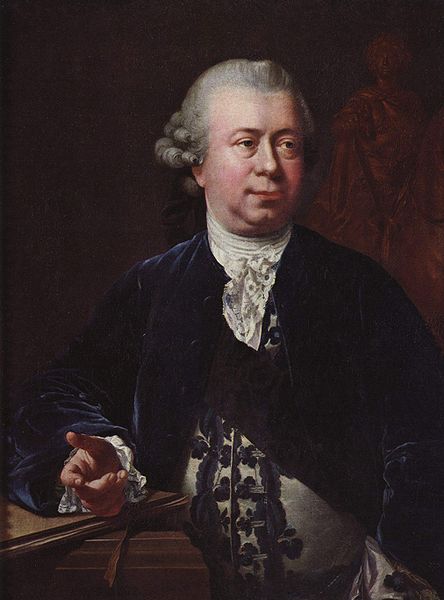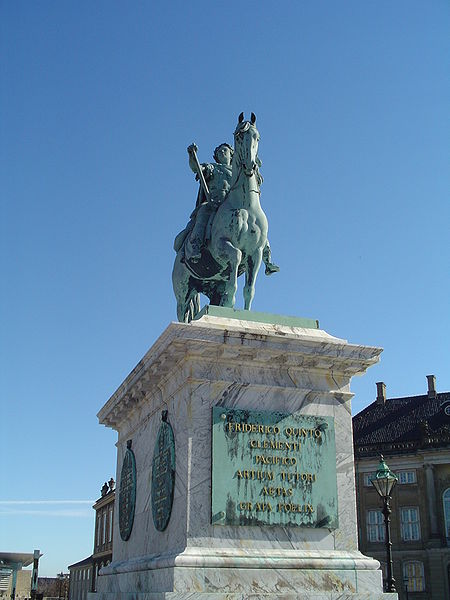<Back to Index>
- Chemist Lloyd Augustus Hall, 1894
- Sculptor Jacques François Joseph Saly, 1717
- Member of the French Resistance Jean Moulin, 1899



Jacques François Joseph Saly, also known as Jacques Saly (June 20, 1717 – May 4, 1776), French-born sculptor who worked in France, Denmark, and Italy, was born in Valenciennes to Francois Marie Saly and wife Marie Michelle.
He
began his training as a sculptor at nine years of age under local
master Antoine Gilles in Velenciennes from 1726-1727. In spite of his
parents' meager income, he was sent to Paris in 1732 to train in the
studio of sculptor Guillaume Coustou. At the same time he attended the French Academy of Art, the Académie royale de peinture et de sculpture, winning medals in 1734, 1737 and 1738.
Winning
that last medal, first place in the gold medallion competition, gave
him the right to study at the French Academy in Rome (l´Academie de France á Rome).
He first received his stipend in 1740, and he arrived in Rome October
13, 1740, He stayed there for eight years between 1740-1748, and lived
at the Academy. The goal here was that through the study of antiquities
and the masters of the past, one would develop and refine ones artistic
taste. More practically it meant making marble copies of these for the
French king. In 1742 he made a monumental portrait bust of Emanuel Pinto de Fonseca, Grand Master of the Order of the Maltese Cross. In 1744 he made a bust of a little girl which is one of the most reproduced sculptures from the 1700's.
He became one of the first French members of the Accademia degli Arcadi in Rome 1744, and of the Florence Academy in 1748, and of the Academy in Bologna. He had close relations with Giovanni Battista Piranesi. He traveled back to his home via Naples, Florence and Bologna,
and arrived back in Valenciennes in the beginning of March 1749. The
works he had sent home had received such attention that his hometown
commissioned a full standing portrait of King Louis XV from him. The marble statue was erected in 1752, and destroyed in 1792. A plaster bust of Louis XV was also made that same year. He
went on to Paris, where he became a member of the Paris Art Academy in
1751 with his work "A Fawn with a Kid". He was assistant professor at
the Paris Academy 1751-1753. He exhibited at the Paris Salon 1750-1751,
1753. He created a plaster bust of Madame de Pompadour in 1752, and a statue of Amor for her the next year. In 1752 Saly was commissioned to create a sculpture of King Frederick V of Denmark on horseback to be placed in the center of the courtyard of Amalienborg Palace. The equestrian statue was commissioned by Adam Gottlob Moltke, head of the Danish Asiatic Company, as a gift to the king. But while Moltke’s company offered to finance
the statue, it was the government, however, who chose the sculptor.
Count Johan Hartvig Ernst Bernstorff wrote to the Danish Legation secretary to the French Court in Paris Justitsråd Joachim Wasserschlebe to find a suitable French sculptor. Sculptor
Edmé Bouchardon rejected the offer, but suggested Saly, who
wanted a significant sum for the model and free housing in Copenhagen.
The government concluded the contract with Saly in Spring 1752, but due
to conflict with ongoing projects Saly did not arrive in Denmark until
October 8, 1753, bringing with him his parents, his two sisters and at
least one assistant, Journée, along with his family. Work began on the monument that same year. During the same period of time the Royal Danish Academy of Art (Det Kongelige Danske Kunstakademi)
was officially established with offices at Charlottenborg on Frederik
V’s birthday, March 31, 1754. Saly held the main speech at the event, a
snub against the current Academy Director architect Nicolai Eigtved.
Saly was made member of the Academy; was named professor, and received
a residence at Charlottenborg. Several months later after Eigtved died
suddenly on July 7, 1754, Saly was named Eigtved’s successor to the
position. He served as Director of the Academy from July 25, 1754-July
15, 1771, and he was given a lifelong yearly pension in 1760. Saly
worked hard to improve the Danish Academy after the model of the French
Academy. He sought to bring about these changes, all the while working
on his model of the equestrian statue for the king, the primary
artistic work associated with his many years in Denmark. Saly was also
instrumental in bringing his friend from the French Academy and the
years in Italy, countryman and architect Nicolas-Henri Jardin to the attention of King Frederik V as the suitable choice to replace Nicolai Eigtved for the design and building of Frederik's Church (Frederikskirke), now known as The Marble Church (Marmorkirken),
work on which had had begun in 1749. A contract to bring Jardin to
Denmark was concluded on October 12, 1754, a few months after Eigtved’s
death, and Jardin took over Eigtved's professorship at the Academy. Saly
showed the king the first sketch of the equestrian statue on December
4, 1754. The king approved a sketch for the whole monument in August
1755. Then Saly began a thorough study of horses from the king’s
stalls. This resulted in a little model, which he showed the king in
November 1758. Casts of this model are found in both the collection of
the Academy and the State Collection, now the Danish National Gallery. Saly
also sculpted around this same time a life-size bust of the king, of
which seven bronze casts were created, and a sculpture of Moltke, the
head of the Asiatic Company, of which three bronze casts were created. Saly,
after having set up an appropriate studio, carried out the work on the
large model of the equestrian statue 1761-1763, and the plaster cast
was presented to the Academy members on February 3, 1764. The king also
saw this model. Preparations for the bronze casting took four more
years, and Frenchman Pierre Gors did the casting on March 2, 1768. 1768
is officially considered the statue’s completion date. Johann Marin Preissler made
a large engraving of the equestrian statue 1768-1769 in commermoration
of its completion, and The Danish Asiatic Company forged two medallions, one by Wulff and the other by Daniel Jensen Adzer. The
base for the statue, however, was first deliverable in 1770, and the
unveiling of the equestrian statue finally took place in the courtyard
at Amalienborg Palace in August 1, 1771, five years after the King’s
death in 1766. It commands the site still to this day, and has been
restored 1997-1998. Saly
held the post of Academy Director until July 15, 1771, two weeks before
the equestrian statue’s unveiling. He quit in protest over a new set of
rules that gave increased influence to native-born Danes. This all
occurred during the oppressive reign of Johann Friedrich Struensee. Saly was named Knight of the Order of St Michel in Paris, but was not allowed to bear the title while living in Denmark. Saly,
although no longer Director of the Academy, kept the apartment at
Charlottenborg, from 1771 to at least 1774. During this time he tried
to justify an additional sum from the Danish Asiatic Company for his
extraordinary services on the monument to Frederik V, considering how
much longer the statue took to complete than originally planned. He was
not satisfied with the conclusion of his financial negotiations. He left for Paris along with his father on July 2, 1744;
most of the other family members had died by this point. One of his two
sisters had married a French sea officer in Danish service. Back
in Paris in 1775 he could now bear the title of Knight. He was named
Senior Professor at the French Academy in Paris July 29, 1775. Already
seriously ill when he left Denmark, he died May 4, 1776. He had never
married.